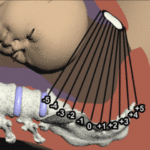Central Venous Catheter Transcript
Central Venous Catheter Placement
This is Dr. Cal Shipley with a review of central venous catheter placement.
Point of Entry
A central venous catheter may be placed via the left or right internal jugular vein in the neck, the left or right subclavian vein located beneath the clavicle (collarbone) and the left or right femoral vein located in the groin ( also known as the inguinal region Irrespective of which of these six entry points is used to insert the catheter, the essential principles of catheter placement are the same. Knowledge of the relevant anatomy of the head and neck is critical to safe and accurate placement of a central venous catheter. Let’s start with a quick review.
Head and Neck Anatomy
Sternocleidomastoid Muscles
The left and right sternocleidomastoid muscles attach at the base of the skull and each muscle has two attachments or heads, a sternal head and a clavicular head. The SCM provides an important anatomical landmark in the placement of a central venous catheter due to the fact that the internal jugular veins lie just posterior to the muscle between the two heads.
Internal Jugular Veins and Carotid Arteries
Removal of the SCMs reveals the full course of the internal jugular veins, positioned just inside the internal jugular veins, and lying somewhat posterior to them are the right and left carotid artery. This lateral view emphasizes the posterior position of the carotid artery relative to the jugular vein. The right internal jugular vein carries deoxygenated blood into the superior vena cava. From the superior vena cava, blood then flows into the right atrium of the heart.
Central Venous Catheter Placement
Internal Jugular Vein Assessment
Let’s turn now to the placement technique for our central venous catheter. The patient is placed in a Trendelenburg position in order to distend the internal jugular veins.
The central venous catheter may be inserted through either the left or the right internal jugular vein. Ultrasound imaging is used to determine the safest side for insertion. Real-time ultrasound images are used to assess the internal jugular vein and carotid artery on each side.
In this example, ultrasound assessment shows good spacing between the right carotid artery and the right internal jugular vein, whereas the left carotid artery and internal jugular vein shows some overlap. Well-spaced vessels reduce the risk of inadvertent and potentially catastrophic penetration of the carotid artery during central venous catheter placement. Once vessel spacing has been assessed and the side chosen for the initial placement attempt ultrasound is used to determine the precise location of the internal jugular vein.
Internal Jugular vein Compressibility and Collapsibility
Relative to the carotid artery, the internal jugular vein is a thin-walled structure, and blood flows through it at low pressures. It can be compressed by gentle pressure applied with the ultrasound head. This compressibility may be seen on real-time ultrasound imaging. Here is a sample of actual real-time ultrasound imaging demonstrating this phenomenon.
Once internal jugular vein location has been determined, the vein is then assessed for collapsibility. That is closure of the vein during normal breathing without intervention from the stenographer. A collapsing vein is not suitable for a safe insertion of a central venous catheter and should trigger an assessment of the jugular vein on the opposite side.
Local Anesthetic
Once a well-spaced compressible non-collapsing vein has been determined, local anesthetic is injected into the skin overlying the internal jugular vein. Prior to injection ultrasound is again used to confirm the location of the jugular vein. Once the local anesthetic has been placed, a needle is inserted into the jugular vein. Under ultrasound guidance. Here’s what the real-time ultrasound images look like.
A few CC of blood is drawn into the attached syringe to confirm placement within the vein. The withdrawn blood should be the deep red almost purple color characteristic of veins. If the blood is bright red and/or if the blood withdrawn enters the syringe in a pulsatile fashion, the needle may have inadvertently entered the carotid artery. If this is suspected, the needle should be removed and a fresh attempt made to enter the internal jugular vein.
Insertion of Guidewire and Dilator
Once the needle tip has been successfully placed within the internal jugular vein, a guidewire is inserted through it. For a typical adult male, in a right internal jugular vein insertion, the guidewire is advanced about 20 centimeters so that the tip lies within the right atrium of the heart. With the needle in place to protect the guide wire, the skin opening created by the needle puncture is enlarged with a scalpel. The needle is then removed, leaving the guidewire in place. Ultrasound is used to confirm that the guidewire is still within the internal jugular vein.
Here is a typical long-axis view of a guidewire correctly placed within the jugular vein. A short axis view on the other hand looks at a cross-sectional view of the vessels and on.
A dilator is inserted over the guidewire to prepare the soft tissues of the neck for passage of the central venous catheter. Typically, the dilator is inserted just a couple of centimeters into the internal jugular vein and then withdrawn. The central venous catheter is now ready for insertion.
Central Venous Catheter Insertion
As mentioned previously, in an adult, the catheter is typically inserted approximately 20 centimeters so that the tip lies within the right atrium of the heart. With the catheter in place, the guidewire is withdrawn. Typically, at this stage, a portable chest x-ray is performed in the procedure suite to confirm that the tip of the catheter is within the right atrium.
Central venous catheters typically have multiple ports or channels running through the main catheter. This example depicts a catheter with four ports. Withdrawal of blood is performed to confirm that the catheter is within the right atrium. Again, the blood is examined for color and for any sign of pulsatile entry into the syringe, possibly indicating an inadvertent carotid artery placement. Blood is then withdrawn from each of the four ports in turn to confirm their patency and then flushed with saline. The catheter is then secured to the skin with sutures and a sterile dressing applied.

